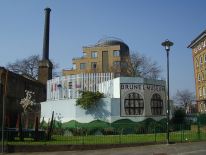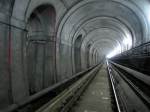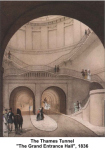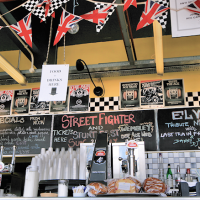The Thames Tunnel & Brunel Museum
 Visit the Victorian ’8th Wonder of the World’ and one of the greatest engineering feats in London’s history.
Visit the Victorian ’8th Wonder of the World’ and one of the greatest engineering feats in London’s history.
The three generations of Brunel’s (Marc Brunel, his son, Isambard, and his grandson Henry) provided & influenced many of Britian’s greatest engineering feats including the Thames tunnel, the Great Western Railway, Hungerford & Clifton suspension bridges, Tower Bridge and Blackfriars Railway bridge. The Thames Tunnel was the only project both Marc and his son, Isambard, worked on together. For Isambard, aged 19, it was his first project in a long and successful career. The Brunel Museum focuses on the Thames Tunnel - the first tunnel to pass underneath the Thames (or any navigable river in the world for that matter) - and provides the opportunity to visit the tunnel and entrance hall.
Construction on the tunnel began in 1825 with the intent to create a way to transport goods more easily from one side of the Thames to the other without interfering with sh ipping. In March, 1843, a full 18 years later, the tunnel finally opened. Considering the technological limitations of the early 19th Century, its completion was almost miraculous. Challenges were numerous including five major collapses and flooding from the Thames. When completed it was considered the 8th Wonder of the World. Within 4 months of its opening over 1 million people had walked through the tunnel. Considering London’s population was only 2 million this is an outstanding number of people. Given how long the tunnel had taken to build, and the great expense incurred, the necessary ramps to facilitate horses and carts to descend into and out of the tunnel were never built and the tunnel became a white elephant. 22 years later (1865), a railway company purchased the tunnel and by 1869 connector tunnels to the entrance and exit allowed steam trains to pass through. Finally the tunnel served a purpose - a purpose which just changed again in 2010 as it changed to be part of the new London Overground Orbital rail line.
ipping. In March, 1843, a full 18 years later, the tunnel finally opened. Considering the technological limitations of the early 19th Century, its completion was almost miraculous. Challenges were numerous including five major collapses and flooding from the Thames. When completed it was considered the 8th Wonder of the World. Within 4 months of its opening over 1 million people had walked through the tunnel. Considering London’s population was only 2 million this is an outstanding number of people. Given how long the tunnel had taken to build, and the great expense incurred, the necessary ramps to facilitate horses and carts to descend into and out of the tunnel were never built and the tunnel became a white elephant. 22 years later (1865), a railway company purchased the tunnel and by 1869 connector tunnels to the entrance and exit allowed steam trains to pass through. Finally the tunnel served a purpose - a purpose which just changed again in 2010 as it changed to be part of the new London Overground Orbital rail line.
The Brunel Museum is housed in Marc Brunel’s ‘Engine House’. It contains an exhibition of display panels, videos, models and original artifacts. The Engine house was built a year before the Thames Tunnel opened, and was originally used to house the steam engines that drove the pumps to keep the Thames Tunnel dry.
The “Rotherhithe shaft” - the main entry and exit point for construction of the tunnel - was transformed into the  Rotherhithe Grand Entrance Hall by Brunel to be a showcase entrance to the facility, with grand sweeping staircases down into the facility. The Grand Entrance Hall was closed to the public for over 140 years, but can be visited today on one of the regular tours organised by the Brunel Museum - generally on Tuesday, Saturday and Sunday.
Rotherhithe Grand Entrance Hall by Brunel to be a showcase entrance to the facility, with grand sweeping staircases down into the facility. The Grand Entrance Hall was closed to the public for over 140 years, but can be visited today on one of the regular tours organised by the Brunel Museum - generally on Tuesday, Saturday and Sunday.
While London Overground utilizes the tunnel for its services, they do continue to allow periodic access to view the tunnel on organized tours. These visits involve the floodlighting of the tunnel for both views from platforms as well as a special floodlit train ride through the tunnel. See website below for more details and dates on these special events as they change.
The Brunel Museum is open daily from 10-5. Minimal admission fees apply. There is a cafe and a bookstore on site. See their website for more details on special tours and events: http://www.brunel-museum.org.uk/
Located at: Railway Avenue, Rotherhithe, London SE16 4LF
Closest rail: Rotherhithe Overground (Tube: Canada Water)
One comment on “The Thames Tunnel & Brunel Museum”
Leave a Reply
Recommended reading
- Migliori Casino Online
- Migliori Casino Online
- Casino Non Aams Italia
- Casinos Not On Gamstop
- UK Online Casinos Not On Gamstop
- Casino Sites Not On Gamstop
- Casino Sites Not On Gamstop
- Non Gamstop Casino
- Casinos Not On Gamstop
- Non Gamstop Casinos UK
- Best Non Gamstop Casinos
- Meilleur Casino En Ligne France
- Non-gamstop UK Casinos
- UK Gambling Sites Not On Gamstop
- Casino Sites In UK
- Casinos Not On Gamstop
- Non Gamstop Casinos
- Sites Not On Gamstop
- Meilleur Site De Casino En Ligne
- Casino En Ligne Fiable
- Non Gamstop Casinos
- UK Betting Sites
- Non Gamstop Casino Sites UK
- Non Gamstop Casino UK
- Casino Online Non Aams
- Casino Non Aams Sicuri
- Sites De Paris Sportifs En Belgique
- Meilleur Casino Belgique En Ligne
- Meilleur Site De Casino En Ligne Belgique
- Casino En Ligne
- 비트코인 베팅사이트




Thanks for directing me here! I’m going to keep my eyes peeled for access underground in the unconventional way.
Anna